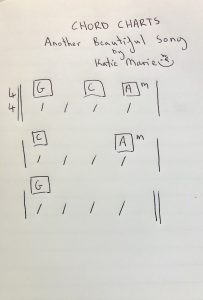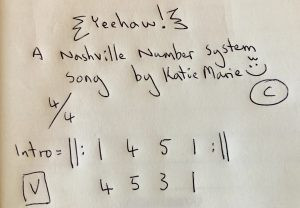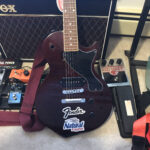Being prepared with accurate chord charts is crucial for efficient and productive studio recording sessions. Whether you’re a guitarist being hired for a session or a songwriter laying down tracks, clear and concise charts ensure everyone is on the same page, saving valuable studio time and allowing for a smoother creative process. Over years of diverse recording experiences, I’ve encountered everything from meticulously detailed scores to minimal guidance. This guide will break down how to create effective chord charts, focusing on clarity and practicality for guitarists in studio environments.
Why Chord Charts are Essential for Guitarists in Studio
Chord charts serve as a musical roadmap, providing essential information for guitarists and other musicians involved in a recording session. They outline the song’s structure and harmonic progression, enabling musicians to quickly understand their parts and contribute effectively. For guitarists specifically, chord charts are invaluable for:
- Efficiency: Well-prepared charts minimize rehearsal time and allow for quicker takes, maximizing studio time and budget.
- Accuracy: Clear charts reduce ambiguity and the likelihood of errors, ensuring the guitarist plays the correct chords and song arrangement.
- Flexibility: Certain types of charts, like the Nashville Number System, offer flexibility for on-the-fly key changes, beneficial in collaborative and evolving projects.
- Professionalism: Providing professional-looking and easy-to-read charts demonstrates preparedness and respect for everyone’s time and expertise.
- Focus on Performance: When guitarists aren’t struggling to decipher vague instructions, they can focus on their performance, tone, and musicality, leading to better recordings.
Essential Elements of Effective Guitar Chord Charts
Before diving into different types of chord charts, let’s cover the fundamental elements that contribute to their effectiveness, especially for guitarists:
-
Song Structure: Clearly define the song sections using standard abbreviations. This provides a roadmap for the entire song. Common abbreviations include:
- V: Verse
- C or CH: Chorus
- B or Bridge or BD: Bridge
- Pre-C: Pre-Chorus
- Inst: Instrumental
- Outro: Outro
- Intro: Introduction
- M8: Middle 8 (often used in UK English for Bridge)
-
Chord Symbols: Use standard chord notation (e.g., Am, G, Cmaj7) that guitarists are familiar with. Ensure chord names are accurate and legible.
-
Time Signature: Indicate the time signature at the beginning of the chart (e.g., 4/4, 3/4, 6/8). This is crucial for understanding the rhythmic feel of the music.
-
Rhythm Markings (Optional but Helpful): While not always necessary for simple songs, rhythm markings can be beneficial for more complex parts. They indicate the duration of each chord within a bar. Common methods include:
- Underlines: Lines under chords can represent beats. For example, in 4/4 time, four underlines would represent four beats in a bar.
- Beat Numbers: Explicitly writing beat numbers under chords (1, 2, 3, 4) can be very clear.
- Spacing: Spacing chord symbols proportionally to their duration in the bar can also convey rhythmic information visually.
Types of Chord Charts for Guitarists
There are several approaches to creating chord charts, each with its own strengths and weaknesses. The best choice often depends on the complexity of the music and the guitarist’s reading proficiency.
1. Lyrics with Chords: Simple and Accessible
 Example of a lyrics with chords chart for guitar, showing simple chord placement above lyrics.
Example of a lyrics with chords chart for guitar, showing simple chord placement above lyrics.
This is often the most approachable type of chord chart, especially for guitarists who are newer to reading charts or for songs with straightforward chord progressions. Chord symbols are placed directly above the lyrics where the chord changes occur.
Pros:
- Easy to Read: Very intuitive and requires minimal music theory knowledge.
- Quick to Create: Simple to write out, even by hand.
- Focus on Song Form: Lyrics provide context and help follow the song’s narrative.
Cons:
- Lack of Rhythmic Precision: Doesn’t explicitly show chord durations or rhythmic placement within the bar. This can be problematic for songs with syncopation or complex rhythms.
- Less Detail: Limited information beyond chord changes and lyrics.
Best for: Simple songs, singer-songwriters, beginner guitarists, casual jam sessions, songs where rhythmic feel is intuitive.
2. Standard Chord Charts: Clear Rhythmic Structure
 Example of a standard chord chart for guitar in 4/4 time, illustrating rhythm markings beneath chord symbols.
Example of a standard chord chart for guitar in 4/4 time, illustrating rhythm markings beneath chord symbols.
Standard chord charts move beyond just lyrics and focus on the structure and rhythm of the chords. They typically present chord symbols arranged in bars, reflecting the song’s time signature. Rhythm markings are often used to clarify chord durations within each bar.
Pros:
- Rhythmic Clarity: Rhythm markings provide precise information about how long each chord should be played.
- Structural Overview: Bars clearly delineate musical phrases and the song’s form.
- More Detail: Offers more musical information than lyrics-with-chords charts.
Cons:
- Requires Basic Music Reading: Guitarists need to understand time signatures and rhythm markings.
- Can Be More Time-Consuming to Create: Requires more attention to rhythmic detail.
Best for: Most studio sessions, songs with moderate rhythmic complexity, guitarists comfortable with basic music notation, situations where rhythmic accuracy is important.
In the example chart above, in 4/4 time, you can see rhythm markings represented by lines under the chord symbols. The first bar shows G chord for two beats, C for one beat, and Am for one beat. This clearly communicates the rhythmic subdivision within the measure for the guitarist. Another common method, as shown in the second bar example, is to imply rhythm through spacing, where the G and C chords are each given two beats visually within the bar.
3. Nashville Number System: Flexibility and Key Changes
 Example of a Nashville Number System chart for guitar, demonstrating numbers representing chords in a key.
Example of a Nashville Number System chart for guitar, demonstrating numbers representing chords in a key.
The Nashville Number System is a streamlined and versatile method, particularly popular in Nashville studios and among session musicians. It uses numbers to represent chords within a key, rather than chord names (like G or Am). This system is incredibly useful for quickly transposing a song to a different key without rewriting the entire chart.
How it works for guitarists:
-
Numbers Represent Chords: Each number corresponds to a degree of the scale in the song’s key.
- Major Key Example (Key of C): 1=Cmaj, 2=Dm, 3=Em, 4=Fmaj, 5=Gmaj, 6=Am, 7=Bdim
- Minor Key Example (Key of A minor): 1=Am, 2=Bdim, 3=Cmaj, 4=Dm, 5=Em, 6=Fmaj, 7=Gmaj
-
Chart Example: A progression in C major might be written as:
| 1 | 1 | 4 | 5 |
| 1 | 1 | 2 | 2 |This translates to:
| C | C | F | G |
| C | C | Dm | Dm | -
Key Transposition: The beauty of this system is that if you change the key to G major, the same number chart applies!
| 1 | 1 | 4 | 5 |
| 1 | 1 | 2 | 2 |In G major, this now becomes:
| G | G | C | D |
| G | G | Am | Am |
Pros:
- Key Flexibility: Effortlessly transpose songs to different keys.
- Simplified Charts: Numbers are often quicker to write and read than full chord names.
- Industry Standard: Widely used in professional session circles.
Cons:
- Requires Key Knowledge: Guitarists need to understand key signatures and chord relationships within keys.
- Less Explicit Chord Names: Initially, it might require a moment to translate numbers to specific chords.
Best for: Session guitarists, studios, songwriters who frequently experiment with keys, situations requiring quick adjustments and flexibility, musicians comfortable with basic music theory.
4. Full Score: Comprehensive Musical Detail
A full score is the most detailed type of chart, using traditional music notation. It includes melody lines, rhythms, harmonies, dynamics, and articulation markings. While common in classical and orchestral music, full scores are less frequently used in popular music studio sessions, especially for guitar charts.
Pros:
- Maximum Detail: Captures every nuance of the music.
- Universally Understood (by trained musicians): Standardized notation system.
- Precise Communication: Leaves no room for ambiguity.
Cons:
- Steep Learning Curve: Requires significant music reading proficiency. Many guitarists in popular music are not fluent in standard notation.
- Time-Consuming to Create: Creating full scores is a lengthy process.
- Overkill for Many Situations: Often unnecessary detail for typical studio guitar parts.
Best for: Highly arranged music, complex instrumental pieces, situations where extreme precision is needed, guitarists with strong music reading skills, potentially for notating specific lead lines or intricate fingerstyle parts.
Tips for Creating Effective Guitar Chord Charts
- Clarity is Key: Prioritize readability. Use clear fonts, write legibly (if handwritten), and avoid clutter.
- Accuracy Matters: Double-check chord names and song structure for accuracy. Mistakes in charts waste studio time and create frustration.
- Conciseness: Include only essential information. Avoid unnecessary details that can make the chart cluttered.
- Standard Abbreviations: Use widely recognized abbreviations for song sections and musical terms.
- Test Your Charts: Have another musician (ideally a guitarist) read your chart before the session to ensure it’s clear and understandable.
- Consider Your Audience: Choose the chart type that best suits the guitarist’s reading abilities and the complexity of the music. For most studio guitar work, standard chord charts or Nashville Number System charts offer a good balance of detail and practicality.
Conclusion
Creating effective chord charts is a fundamental skill for anyone involved in studio recording, particularly for guitarists and those working with guitarists. By understanding the different types of charts and focusing on clarity, accuracy, and the needs of the musicians involved, you can ensure smoother, more productive, and ultimately more successful studio sessions. Choosing the right type of chord chart—from simple lyrics with chords to detailed standard charts or the flexible Nashville Number System—depends on the musical context and the guitarist’s preferences and skill set. Mastering chord charts is an investment that pays off in efficiency, professionalism, and better musical outcomes in the studio.

